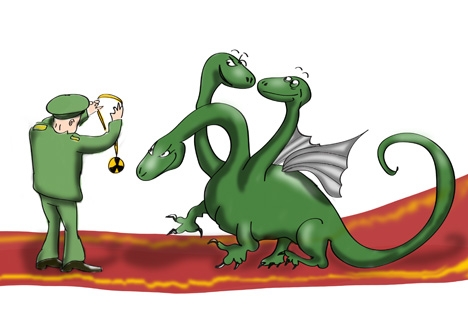
Drawing by Niyaz Karim
The first spacecraft designed by a private company, the Dragon, produced by Elon Musk's SpaceX, will be launched on April 30 to the International Space Station (ISS). The flight will be unmanned, and the ship will transport nearly 1,000 lbs of cargo. This is the second test launch of the ship, and its first docking with the ISS; it was recently granted permission to do so by NASA.
Over the next three years, at least 12 launches of Dragon are planned, which will demonstrate how likely the new generation of spacecraft and launch vehicle designers will be in taking a share of the market from traditional manufacturers.
At first glance, Russia has the most to lose from the new development. Since the decommissioning of the space shuttle system, the country has had a monopoly on the delivery of both people and cargo to the station. Although the Europeans have already worked to break the cargo monopoly with the development of the ATV, the Dragon, which can be used to transport up to seven passengers; four passengers and two tons or cargo; or six tons of cargo, poses a much more serious challenge.
However, the Russian Federal Space Agency has raised no objections to the launch of the Dragon to the ISS. In fact, the ship may benefit the Russian Federal Space Agency.
What good is there in a new competitor?
Dragon's claimed specifications command respect. It can carry six tons of cargo at a launch cost of around $100 million, which is a third the cost of sending a similar load on the Progress. Additionally, the challenge from Dragon has sped up plans for the Russian Prospective Piloted Transport System (PPTS). And since the Russian ship is still in the development stage, it can learn from the mistakes of the Dragon.
Russian designs are ambiguous when it comes to a series of key systems. Initially, the development of the PPTS was carried out based on the creation of a family of Rus-M launch vehicles, but this project has been closed in favor of the Angara model and prospective modifications to the Soyuz. Angara, it seems, is coming close to realization: the construction of launch facilities at Plesetsk is in full swing, and the missile launch is planned for 2013.
Thus, in the foreseeable future the Russian aerospace industry is tasked with creating a ship that can compete with Dragon, and not only in the terms of the cost of the launch, but also for all other parameters, such as future lunar or martian missions. Dragon's flights to the ISS may serve as an important stimulus in this case.
Nuclear outlook
An interesting turn in the fate of the new Russian project may be the development of nuclear propulsion for deep-space missions, which could significantly improve the performance of prospective spacecraft, including, possibly, manned spacecraft for flights to Mars, and, possibly, for more distant voyages in the future. The first units will be collected next year, ground testing of the working prototype will begin in 2014, and by 2017, the nuclear engine will be ready to be launched into space.
According to specialists at the Rosatom State Nuclear Atom Corporation, the development and construction of a nuclear power plant for spacecraft will cost more than $247 million. At the same time, public funding of this program in 2010 amounted to about $17 million, and the total investment required for the period before 2019 exceeds $580 million, meaning that a significant increase in expenditures for these purposes is required.
NASA also began a similar program in 2003; the organization spent several hundred million dollars on the project before funding was discontinued.
It is expected that a nuclear engine would be suitable for flights into deep space, where power supplied by solar panels is not enough to power electric-propulsion motors. A nuclear engine provides hundreds of kilowatts of power as opposed to the dozens of watts provided by solar panels, which dramatically increases the load on electric-propulsion motors. Spacecraft equipped with a nuclear power plant can perform the role of a space tugboat, helping research probes reach high speeds, thereby reducing the time needed for flights to reach distant planets in the solar system, and also perhaps increasing the range of manned missions without a critical increase in duration. In addition, an nuclear power plant allows for increasing the payload of ships when flying into deep space, and, in particular, for improving their protection against radiation, the lack of which is still one of the main obstacles to manned flights into the depths of the solar system.
In the near term, Russia’s space plans are not particularly ambitious. Russia has a promising vehicle, which is capable of putting a spacecraft into orbit and is comparable to Dragon, and that vehicle will fly before the end of 2013. From this base product, it will be possible to create a new generation of spacecraft. The deadlines for its development are tight: besides the already operating ATV and Dragon, the CST-1000 from Boeing and Cygnus from Orbital Science corporation are in development. Nobody knows when a new Russian spacecraft will be created, and what it will be, but it is clear that operating Soyuz and Progress forever is impossible, and in the next decade the competition will become fiercer.
Ilya Kramnik is an analyst with Voice of Russia.
All rights reserved by Rossiyskaya Gazeta.
Subscribe
to our newsletter!
Get the week's best stories straight to your inbox